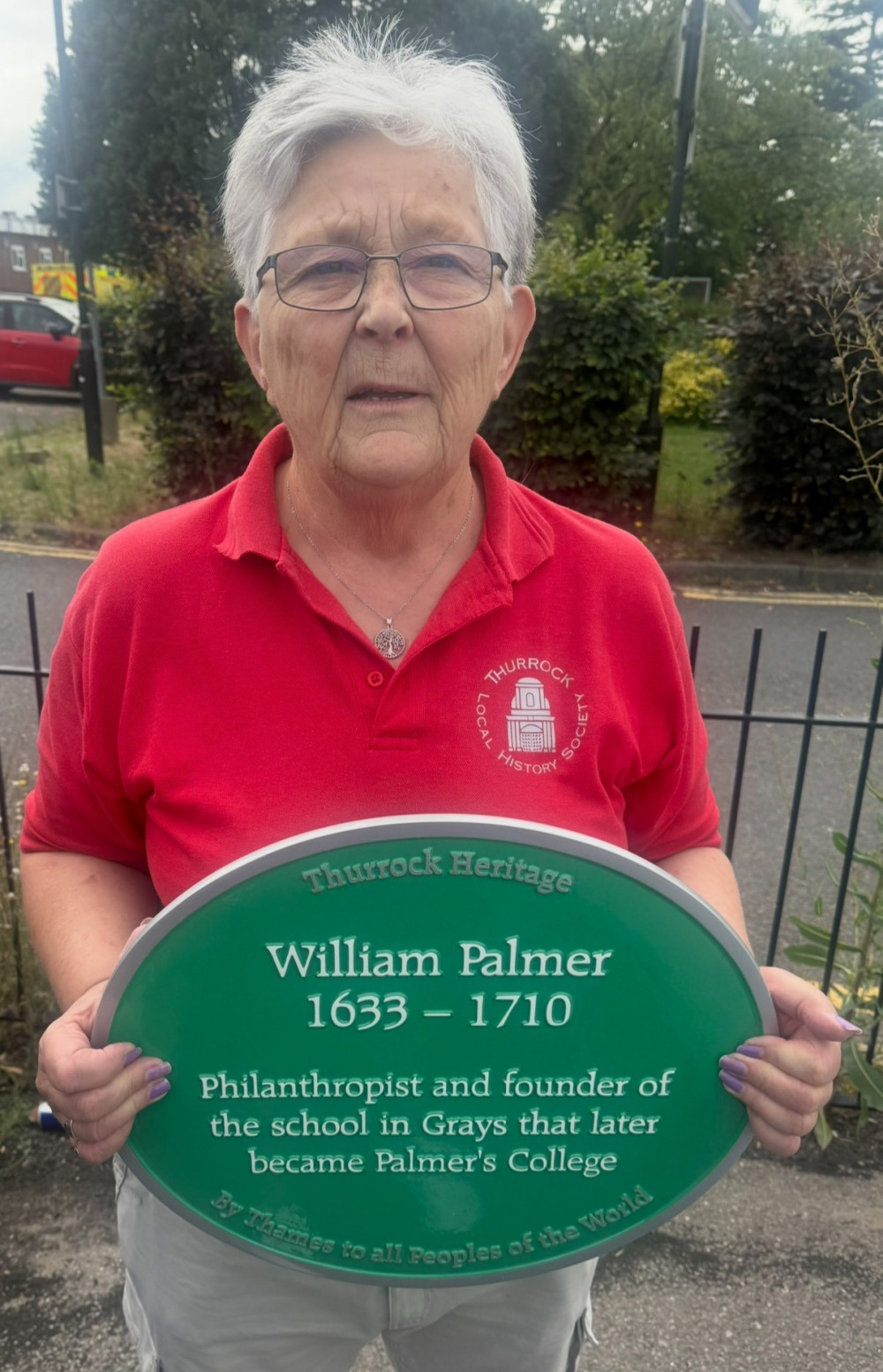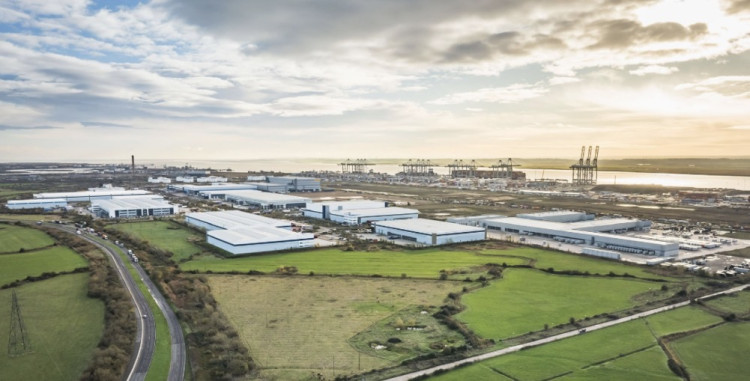Plaque marks centuries of benefit to the borough from the legacy of William Palmer
By Nub News Reporter 6th Oct 2025
By Nub News Reporter 6th Oct 2025


A GREEN plaque will be mounted at USP Palmers College in Grays this afternoon (Monday, 6 October) to commerate the life of William Palmer.
The plaque has been presented to the William Palmer Trust by Thurrock History Society, a Green Plaque honouring its namesake William Palmer (1633-1710).
It will be mounted on the outer gate of the USP College, formerly Palmer's 6th Form College and Palmer's Girls School, so it may be viewed at all times by the public.
A special 'unveiling' ceremony will take place at 3.30pm.
William Palmer was a merchant, born in London in 1633. He was the Lord of the Manor of Grays, having moved to live in the country at Stifford in 1669, following the ravages of the Plague and the Great Fire of London.
Being a wealthy landowner with no heirs, in 1706 William Palmer decided to settle some property as a Trust to provide a school and income to pay the salary of a teacher. Having connections with the Church, he arranged to have a school built in the grounds of St Peter & St Paul in Grays.
It was his stated intention that the school and income was "…to teach 10 poor children of this Parish to read, write and cast accounts and to instruct them in the Latin tongue", as well as other charitable acts for the more general benefit of the poor.
Following William Palmer's death in 1710, Trustees were appointed to ensure that his wishes were kept.
Down the centuries, subsequent groups of local people have served as Trustees and have maintained, preserved and overseen the proper use of the legacy as intended by William Palmer.
In the 1800s a new school was built on the junction of Southend Road with Chadwell Road and in the early 1930s the boys and girls were separated when the Palmer's Girls School was built on some land purchased further along Chadwell Road - its present site. In the 1970s Palmer's Boys School was closed and the land sold to provide further funds for the Trust. At that time, Palmer's Girls School became Palmer's Sixth Form College.
In 2017 the Sixth Form College merged with Seevic College to become Seevic & Palmer's General Further Education College, now renamed USP College.
The Work Of The Trust Today
Recent changes to the Trust boundary restrictions now enables the Trust to provide funding for disadvantaged pupils who reside within the Trust area of the three Grays parishes; Grays Thurrock, Grays North and Stifford, as defined by the Chelmsford diocese.
The parish boundaries are identified and mapped on the Church of England website: www.achurchnearyou.com.
Schools which have qualifying pupils who live within the Trust boundary area can apply for financial assistance from the Trust. The Trustees will consider applications for pupils who are in financial need, for which the receipt of free school meals and/or pupil premium allowance by the school or college are examples of sufficient proof of financial need for a pupil.
The Trust can provide financial support for extra-curricular activities or trips where families are requested to pay towards the costs. Also, if a school purchases equipment or runs a club which would be used by a percentage of children who meet the criteria of being disadvantaged and living within the boundary area, the Trust may consider contributing up to that percentage.
The Trust cannot provide funds for those costs which are provided from Governmental grant funding.
The Role of Trustees
Anyone can apply to become a Trustee or invitations may be offered upon a vacancy arising. Potential candidates are interviewed for suitability based on their relevant experience and their acceptance by the Charities Commission who oversee the work of the Trust.
A TIMELINE TO TODAY'S EVENT
1706 FIRST TRUST DEED
William Palmer established the Trust and conveyed the following properties to the Trustees:
I. Plot of ground adjacent to Grays churchyard
II. Five houses in White Cross Street, Cripplegate, London
III. Shop in Lombard Street, London
He specified that ten poor children of the Parish should be taught to read and write and cast accounts and instructed in the Latin tongue.
He also described the size of the School House to be built (20 ft by 18 ft) and how much the schoolmaster was to be paid (£40 per year) and provided 40 shillings for an annual dinner for the auditors.
1709 Richard Butler became schoolmaster
1710 Land in Orsett Road, near the junction with the High Street, was provided by William Palmer and a house was built for the Schoolmaster.
The following schoolmasters followed Richard Butler although the income of the Trust was not sufficient to pay the whole of the master's salary until 1787:
1709 Samuel Wright
1732 Revd John Walker
1754 Benjamin Wells
1780 John Horncastle
1815 John Baker
1815 William Horncastle
1848 Thomas Hall
1844 The population of Grays had not greatly increased since the founding of the Trust but the development of brick-making and the demand for chalk changed matters. There was a need for increased accommodation in the school and general improvements in the provision of education. A Petition was presented to the Court of Chancery with the result that an Order was made by the Court appointing new Trustees and immediately increasing the number of pupils to 35. The pupils would still receive a free education and the Order allowed the number of pupils to be increased to 50 when an under-master was in post.
1848 The income of the Trust was only £141 a year but, when enough money was accumulated, a new school was built in Orsett Rd adjoining the master's house, to accommodate the increased number of pupils, who could come from neighbouring parishes as well as Grays Thurrock. Thomas Hall remained as Master until 1850 when he was succeeded by James Wm. Ward, Edward J Dearman, Charles Prince, Revd J Benington (Black Harry), Nicholas Hukley Torre and John Wilson during the period to 1858.
1856 The Charity Commission authorised the enlargement of the schoolroom and also allowed the Trustees to accept the first fee-paying pupils.
1858 John Rigge was appointed Master and remained in post until 1893.
1860 The first school room had been removed from the site next to the Church Yard. It was not until 1860 that the Trustees realised the Tilbury Railway Company had taken possession of the site without paying for it. The Railway Company adopted a policy of 'masterly inactivity' and no compensation was ever received by the Trustees.
1864 In May, the Trustees decided to place the school under the inspection of HM Inspector of Schools. In December, they rescinded their resolution, without recording their reasons. The school was now regarded as an Endowed Grammar School and had 109 pupils. Only 41 pupils were not fee-paying.
1870 Part of William Palmer's original settlement, the five houses in White Cross Street, Cripplegate, London were sold for £8,750.
1871 After the enactment of the Endowed Schools Act in 1869, followed by the Education Act in 1870, which introduced elementary education for all, the Charity Commission's attention was drawn to the absence of any efficient provision for the education of Girls and Infants in the Parish of Grays and the need for an Upper School. As a result, a new Scheme was sealed in 1871 which provided for the Trustees to be replaced by sixteen Governors of whom 4 were ex-officio, 4 were to be elected by the parents of children at the school and 8 were to be co-opted by the others. Of the 8 co-opted Governors, 4 were to be women. The Governors were given powers to build a Boys' School for 40 boarders and 100 day scholars and a Girls' School for 25 boarders and 50 day scholars. The scholars were fee-paying but the Governors were allowed to grant scholarships, under a system of competitive examination, which would admit the successful pupils at reduced fees, or without any fee, as long as they lived in the Parish of Grays or the adjacent parishes. The number of Foundation Scholars, as they were known, could not exceed one-fifth of the total number of children at the School. The School leaving age was raised to seventeen. At this time, the population of Grays was under 2,000 but the area began to develop quite rapidly soon afterwards.
1873 Work commenced on building a new school at the junction of Southend Road and Chadwell Road after the Governors sold some of their investments and obtained a mortgage from the Hand-in-Hand Insurance Company. The Governors' resources were so depleted that individual Governors covered temporary loans with their own promissory notes. Disputes arose during the course of construction and both the architect and the contractor instigated legal proceedings which were eventually settled out of court. The Boys' School was completed in 1874 and the Girls' School in 1876 and, this time, the Governors collected the proceeds of sale of the old school.
1893 During the twenty years since 1873, the number of pupils attending the new schools had not increased as expected. In 1884, there were 46 boys and 36 girls, in 1890 there were 67 boys and in 1893, there were only 45 boys. The majority of the pupils were boarders from outside the local area. There was a belief that the Charity established by William Palmer to benefit the poor children of Grays, had been wrongly changed to benefit 'middle class' strangers and there were demands that the assets of the Trust should be sold and the proceeds used to reduce the general education burden on the ratepayers.
The Charity Commission decided to vary the Trust Scheme to give more control of the Trust to the Local Authorities with the composition of the Board of Governors altered to:
Vicar and Churchwardens of Grays 1
Essex County Council 2
Grays School Board 3
Grays Local Board 3
Orsett Board of Guardians 1
Co-opted by other Governors 6
Essex County Council had received funds known as the 'Whiskey Money' from the Government. These were derived from a levy on Public Houses, to enable those closed by Parliament to receive compensation, and which was not needed as there was a change of heart towards Publicans. Essex County Council used these funds and others to aid the School.
A new Headmaster, George Silverwood, was appointed in 1893 and he soon commanded the confidence of all those who were interested in the development of secondary education in Grays.
1894 The new Board of Governors built a Chemical Laboratory and Lecture Room and also used the powers, given to their predecessors in 1871, to establish 16 free scholarships (ten for boys and six for girls) for competition by the pupils in the elementary schools of Grays.
1898 Plans were made to provide new classrooms, a physics laboratory, a gymnasium and a swimming pool but financial problems meant that completion of the work did not occur until 1900 with the headmaster contributing £200 from his own pocket.
1905 In a Report, commissioned by Essex County Council, Professor Michael Sadler wrote:
Grays serves an educational area extending from Rainham on the west to Pitsea on the east, and as far north as Upminster. The work of higher education in this district has been so admirably organised that there is little for me to recommend beyond what has already been accomplished or is now in contemplation. Palmer's Endowed School has already conferred great benefits on the neighbourhood which it serves. It has now been decided to extend its buildings and sphere of work in order that it may become the centre of secondary education (including the instruction of pupil teachers) for the whole district and for evening classes in science and art for Grays. The energy and organising skills which have been shown in the development of the work of this Foundation reflects great credit on all concerned, and not least on George Silverwood, who, helped by the warm support of his Governors and of the leading residents in Grays, has raised the number of the boys' school pupils, during the first twelve years of his Headmastership, from 45 to 138.
1907 More Classrooms, more laboratory accommodation, technical instruction rooms and an art room were completed.
1918 The Boys' and Girls' Schools had separate head teachers from 1876 to 1906 but were reunited under George Silverwood until his retirement in 1918 when they were given their own head teachers. Miss Ellen M Wren was appointed Headmistress of the Girls' School and the Revd H Aldridge Abbott was appointed Headmaster of the Boys' School when the number of boys attending the School was 287. During 1918, the Governors purchased the land where the College is now situated, having sold the Trust's property in Lombard Street in the City of London for £15,000.
From the proceeds of the sale of the Lombard Street property, £3,000 was set aside to provide an income to pay sixteen Palmer scholarships and a further amount was earmarked to assist brilliant but needy pupils to go to university.
1926 The School prospered under the Headship of the Revd Abbott with the number of boys on the role increasing to 450 while, at the same time, Miss Wren also succeeded in increasing the number of girls to 275.
1929 The foundation stone was laid for the new Girls' School to be built on the site of the current College. The Trustees constructed A block, B block, a small Science block and some ancillary buildings, including the caretaker's house with the Old Girls' Association paying for the swimming pool. The School was completed in 1931.
1931 Palmer's School became a Public School.
1937 From 1933, the Boys' School was largely rebuilt to provide a Hall, Library, new classrooms, Gymnasium and Headmaster's House. Both the Boys' School and the Girls' School had facilities for boarding pupils.
At this time, the School lost some of its independence and became a 'voluntary assisted school' mainly funded by Essex County Council.
1944 With the enactment of the Education Act, education became free for all but pupils were required to pass the 11+ examination to be accepted at Palmer's School which was now designated as 'voluntary controlled'. It no longer had a 'comprehensive' intake with wealthier parents able to 'buy' places for their children even if they were not particularly bright.
1945 The Charity Commission sealed a new Scheme. The Governors became responsible for administering the School with funds provided by Essex County Council, which arrangement continued until 1993. The Trustees retained ownership of the Land and Buildings, with the School having the right to use them. The Trust also retained the Investments, which were then producing an income of £1,000 per year, with the beneficiaries being the same as those in the current Scheme.
1946 The Revd Abbott retired in 1946 and was replaced by Mr F J Jordon who remained Headmaster until 1965. Miss Wren had already retired in 1940 and had been succeeded by Miss A Leworthy who was in turn succeeded by Miss K W Jackson from 1962 until 1975.
1954 Miss Leworthy arranged the building of the Open Air Theatre, on Greek lines, with the help of funds provided by the Trust.
1960 The Charity Commission sealed a new Scheme with the beneficiaries being the same as those in the current Scheme.
1965 Mr A K Smetham was appointed Headmaster of the Boys' School.
1971 Work commenced on converting the Girls School into buildings suitable for a Sixth Form College. Essex County Council built the rather 'temporary style' science block, a new hall, a music centre and a refectory with some classrooms over it and some small offices including a first aid room. The original Science block was converted into the Principal's office and a general office. The work was completed in 1977 when the Governors decided that the Boys' School was no longer needed and returned it to the Trustees. Mr Smetham, who had been the last Headmaster of the School and the first Principal of the Sixth Form College, retired in 1979 and Mr F Harsant was appointed College Principal.
1980 A new Trust Scheme, which changed the name of the Trust from 'Palmers Endowed School' to Palmers College Sixth Form College Trust', was sealed and is the one that is currently in force today although various minor amendments have been made from time to time. The Scheme allowed the Trustees to sell the Boys' School and, subsequently, the North Field when it too was declared redundant by the College.
The amount of money realised from the sale of these assets enabled the Trustees to provide many new buildings at the College
The Trustees invested the remainder of the proceeds of the sale of the assets with the CCLA Investment Managers and the income is used to help the designated beneficiaries of the Trust, which include the College and its students.
1984 Mr David Kelly was appointed College Principal on the retirement of Mr Harsant. Mr Bryan Coker became Chairman of the Trust and Mr John Vesey assumed the role of Clerk to the Trustees.
1993 When the College became incorporated as a Further Education College in 1993, the Trust changed its name to 'William Palmer College Educational Trust'. Although the College was now funded and regulated by the Further Education Funding Council, no capital money was forthcoming but when the funding and regulation transferred to the Learning & Skills Council, it provided money to build the 3 Classroom block, 5 classroom block and 12 classroom block (F block) and the College managed to retain its status as a Sixth Form College within the FE Sector.
1998 When Mr Kelly retired, Mr Peter Fenwick was appointed Principal having already been Vice Principal some years earlier. Mr Fenwick retired in 2007 and Mr Mark Vinall was appointed College Principal.
2005 During the years, many former pupils and local residents have contributed prizes and supported the Trust in many ways. In particular, the Watt family have been extremely generous, providing the Hew Watt extension to the Fitness Suite and making a substantial donation towards the cost of the Hew and Molly Watt Dance Studio as well as awarding Hew Watt Bursaries on a continuing basis.
2009 In December, the Charity Commission had issued an Order varying the Scheme so as to regularise the use of the Land and Buildings by the College and also giving the Trustees the power to grant a Lease to the College.
2010 On 1st April 2010, the College became the responsibility of Thurrock Council and the College chose to be designated as a 'Sixth Form College'. Funding came via Thurrock Council but was provided by the Young Persons Learning Agency.
CHECK OUT OUR Jobs Section HERE!
thurrock vacancies updated hourly!
Click here to see more: thurrock jobs
Share:
















